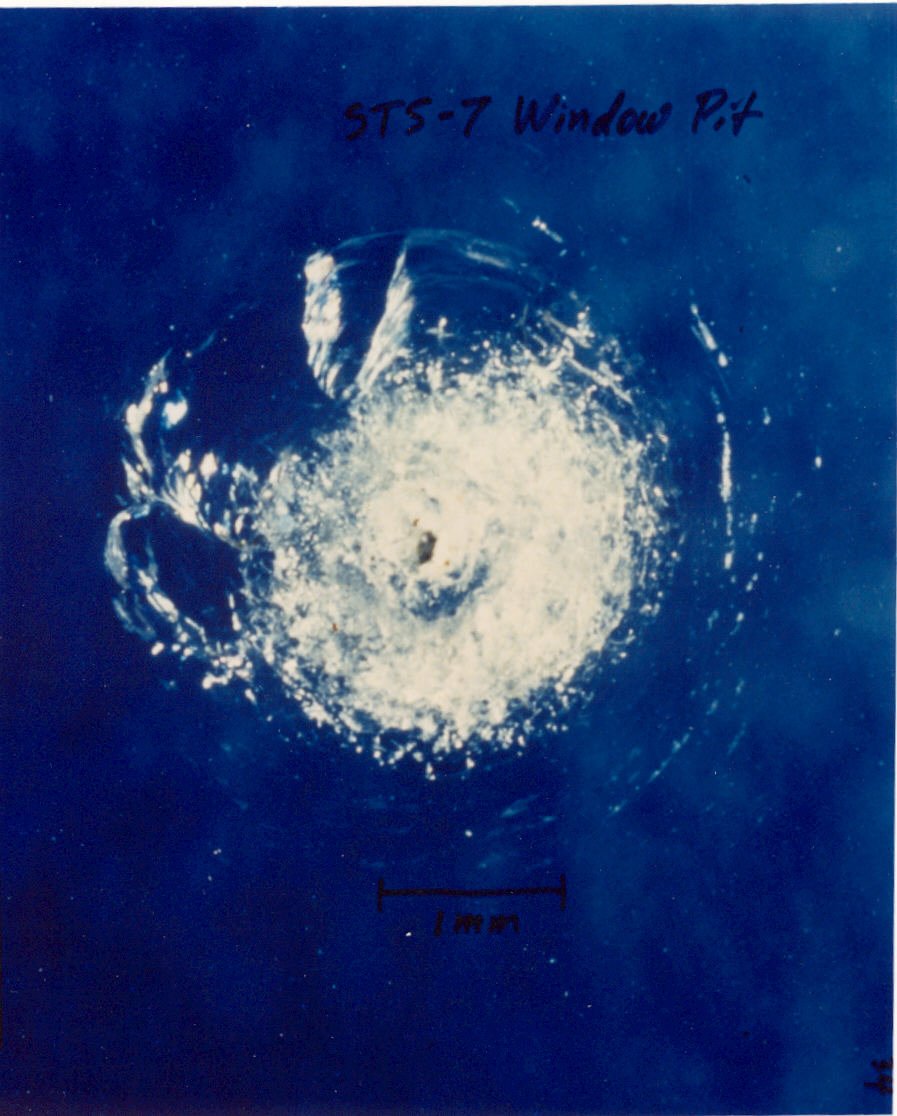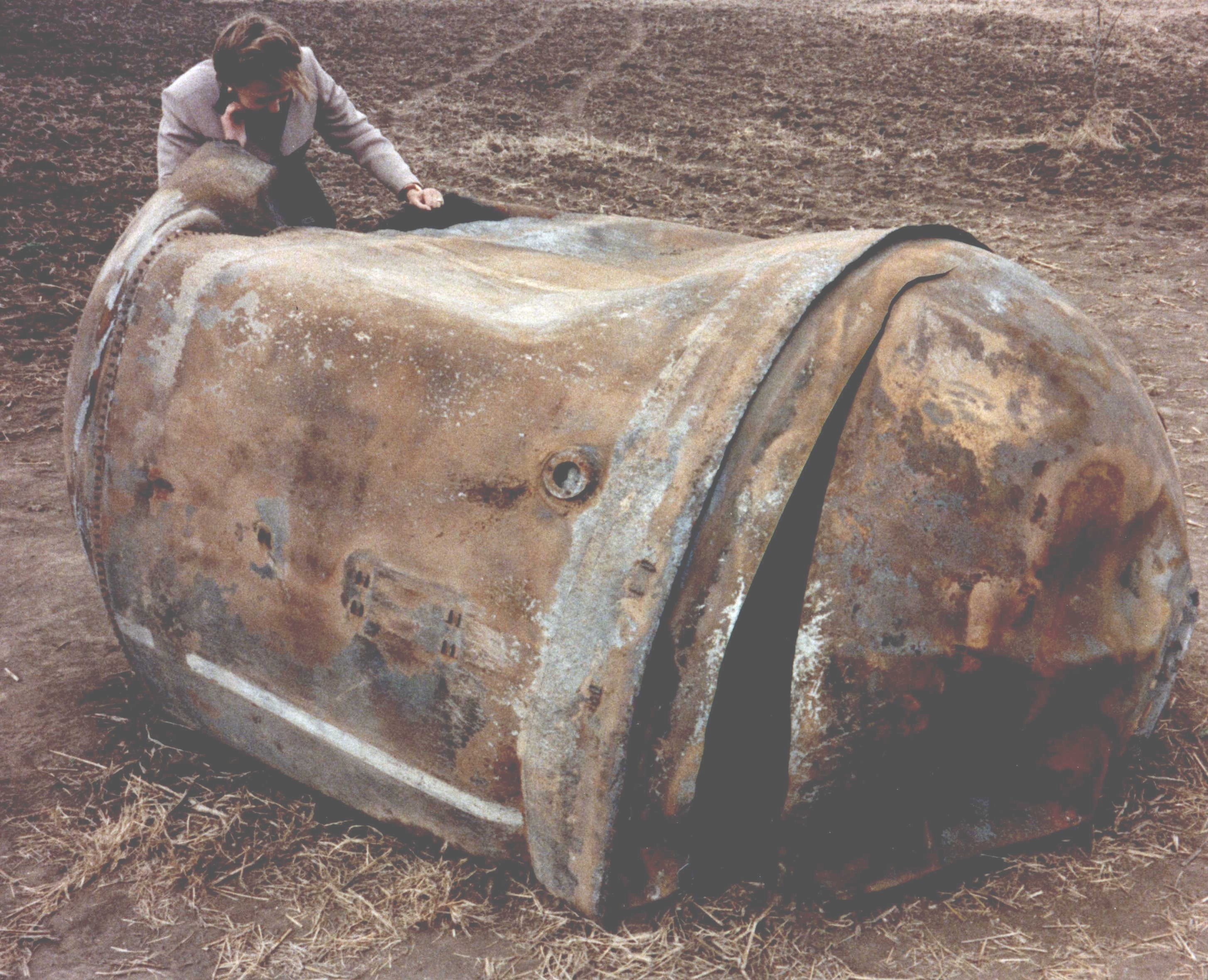In part 1 of this post (here), I showed how crowded our immediate space environment has become with man-made objects. Let us now look at some of the dangers inherent in this situation.
Danger To Manned Spaceflights
A large amount of debris orbiting our planet poses a serious danger to manned spaceflights and in particular the ISS (International Space Station) which has been inhabited continually since 2nd November 2000.
The photograph below taken by astronaut Tim Peake in April 2016 shows a 7mm diameter gouge that was taken out of a window in the ISS cupola (viewing area).
it was believed to have been caused by a small paint or metal flake no more than a few thousandths of a millimetre across.
This danger is nothing new. During the Space Shuttle flights, the vehicles would often return with damage to their surfaces caused by microscopic debris.
The picture below shows damage to the window of the Challenger Shuttle (STS-7) sustained during its flight in June of 1983.
And these were only just minute particles. Imagine the damage that could be caused by larger debris. The film 'Gravity', which shows the catastrophic damage inflicted on the Space Station by debris, portrays very well the potential consequences of such impacts.
Damage To Other Satellites
As well as manned space flights there is also the potential to severely damage or even totally destroy orbiting satellites. On February 10th 2009 two communications satellites, a Russian Strela spacecraft (Cosmos 2251) and an Iridium spacecraft (Iridium 33) collided and produced in the region of 2000 large debris pieces.
The video below, produced by Analytical Graphics, Inc. shows the impact of the two satellites and the subsequent debris clouds. Note how the debris clouds eventually spread out and produce a belt of debris around the globe.
The Kessler Syndrome
This leads us on to what is known as the Kessler syndrome. In 1978 Donald Kessler, a NASA scientist, proposed a scenario in which a collision between two space objects results in a cloud of debris (as seen above). This debris then impacts other satellites causing more debris which then impacts more satellites and so on. This nightmare scenario would cloak the earth in a blanket of debris that would effectively render space flight redundant for decades.
Danger To Life On Earth
What happens when these objects re-enter the Earths atmosphere? Well most of them will burn up harmlessly as they are subjected to the tremendous heat of re-entry. However some pieces can and do survive. The picture below shows a propellant tank of a Delta 2 launch vehicle which survive re-entry and landed near Georgetown, Texas.
What is the likely hood of being hit by a falling piece of space junk? Well very small as most debris that does fall to Earth ends up in the sea. So far there has been only one recorded case of a lady being hit. Her name was Lottie Williams of Tulsa, Oklahoma, who was hit by debris from a Delta second stage as it re-entered in January 1997. Thankfully she was not hurt in the incident. Source
In part 3 of this series, I will take a look at some of the do's and don'ts surrounding debris for all the players involved in space.
30 Steem Competition.
If you are an established or budding poet why not take part in my competition and be in with a chance to win one of the prizes totalling 30 Steem. Just follow this link for full details.
Also please consider following me (I will reciprocate). Some of my posts are about mental health issues while others cover a wide range of subjects. For a taster of my musings please follow these links:-
A local landmark created by a giant....well maybe.
Space Debris - The Problem - Part 1
A Dome For All Seasons - Part 1
A Dome For All Seasons - Part 2 - The saga continues.....
Is social media a force for good?
Sunset over the North Yorkshire Moors
My first attempt at digital art
How too much news may not be good for us
Another one on how dogs can help us
Until next time - take care of yourselves....




